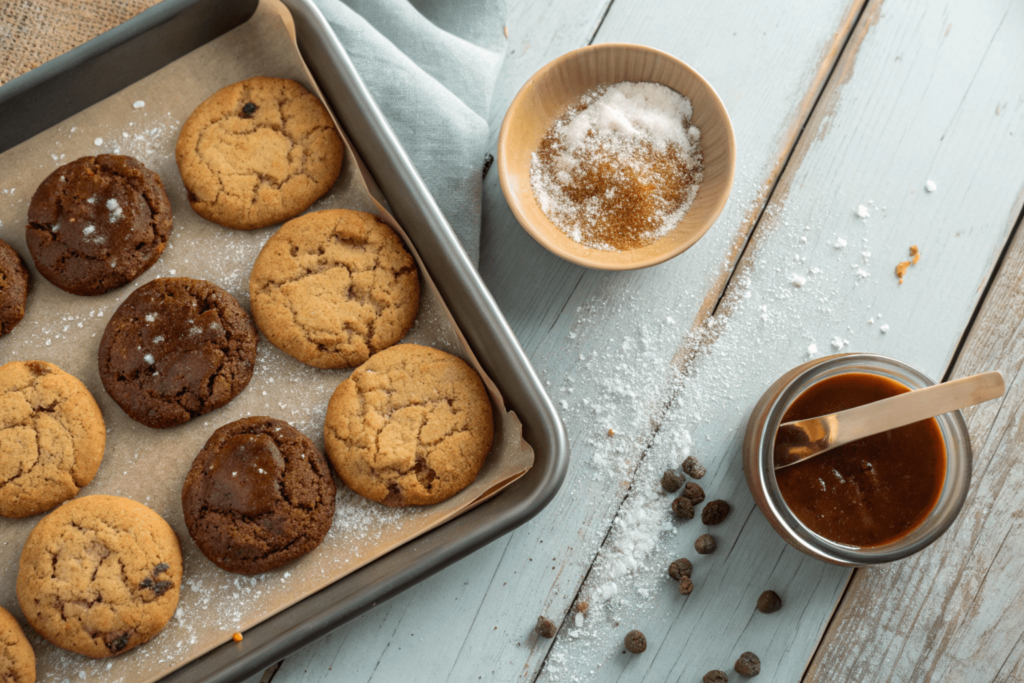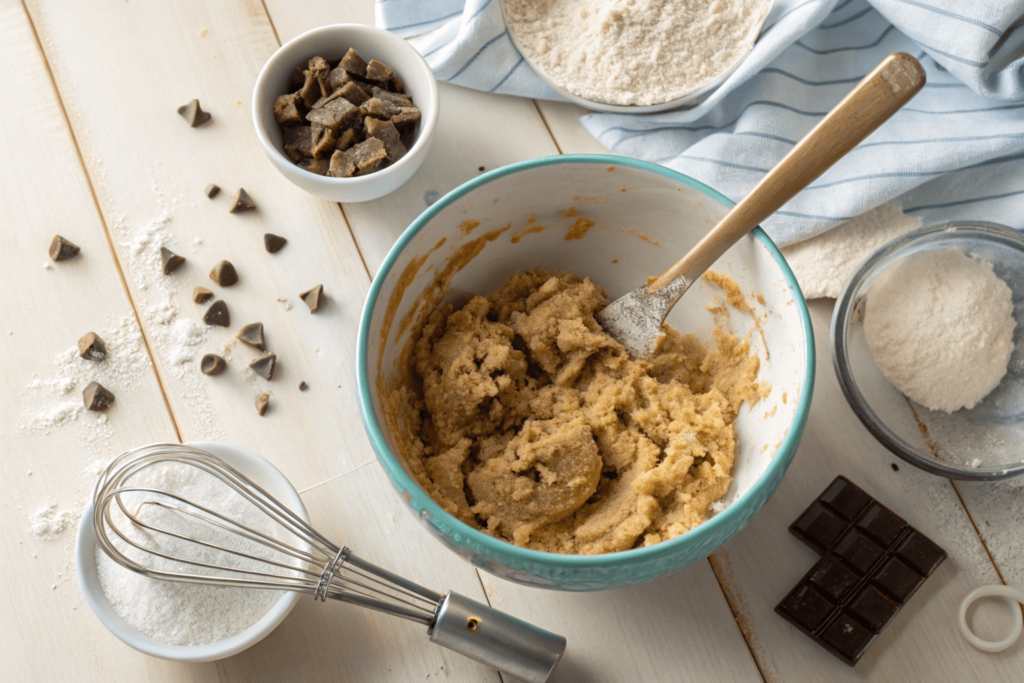
Baking cookies is an art, a science, and, let’s be honest, one of life’s simplest joys. But what happens if you don’t put brown sugar in cookies? Will skipping it ruin your cookies? Will they still taste good? These questions might be racing through your mind as you stare at your mixing bowl, wondering if it’s worth continuing or if you should run to the store.
Brown sugar isn’t just a sweetener; it’s a key ingredient in many cookie recipes. It impacts texture, flavor, and even the way your cookies look. So, let’s dive into the details and explore how leaving out brown sugar affects your cookies—and what you can do to make up for its absence.
Table of contents
The Importance of Brown Sugar in Cookies
What Exactly Is Brown Sugar?
Before we can talk about what happens without it, let’s understand what brown sugar really is. Essentially, brown sugar is just white sugar with molasses mixed back into it. The molasses gives brown sugar its distinct caramel flavor, moist texture, and darker color. There are two main types of brown sugar:
- Light Brown Sugar: Contains less molasses and has a mild, caramel-like flavor.
- Dark Brown Sugar: Contains more molasses, resulting in a richer and more robust flavor.
The sticky texture of brown sugar is due to its higher moisture content, which plays a big role in how it behaves in baking recipes. It’s this moisture that contributes to soft and chewy cookies.
Brown Sugar vs. White Sugar: Key Differences
At first glance, it might seem like white sugar and brown sugar are interchangeable. After all, both are sweet, right? But the differences go beyond taste.
- Flavor: Brown sugar has a richer, more complex flavor because of the molasses, while white sugar is purely sweet.
- Moisture: Brown sugar is moist and helps retain moisture in baked goods, making cookies softer.
- Color: Cookies made with brown sugar often have a golden or slightly brown hue, thanks to the molasses.
These distinctions are why many recipes specifically call for brown sugar. It’s not just about sweetness—it’s about texture, flavor, and the way the cookies bake.
The Role of Brown Sugar in Baking
Let’s break this down scientifically. When brown sugar is added to cookie dough, the molasses acts as a humectant, meaning it attracts and holds onto moisture. This is what keeps cookies soft and chewy, even after they’ve cooled.
Brown sugar also slows down the spread of cookies in the oven. Because it has more moisture than white sugar, it helps the cookies puff up rather than spreading out into thin, crispy discs. This is why recipes that use brown sugar often result in thicker, chewier cookies.
What Happens When You Don’t Use Brown Sugar in Cookies?
Have you ever wondered what happens when you don’t use brown sugar in cookies? Brown sugar is not just a sweetener; it also affects the texture, flavor, and appearance of your cookies. So, what happens when you don’t use brown sugar in cookies? Without it, your cookies might lose their chewy texture and rich, caramel-like flavor. What happens when you don’t use brown sugar in cookies is that they may turn out crisper, lighter in color, and less moist due to the absence of molasses. If you’re curious about what happens when you don’t use brown sugar in cookies, the good news is that you can still bake delicious cookies by using substitutes like white sugar mixed with molasses or maple syrup.
The Flavor Impact: Will Your Cookies Still Taste Good?
Let’s start with the obvious—how will your cookies taste without brown sugar? The short answer: they’ll still be sweet, but the flavor will lack depth. Without the molasses in brown sugar, you lose that warm, caramel-like note that makes cookies so irresistible.
Cookies made with only white sugar tend to taste one-dimensional. If you’re someone who loves complex flavors in baked goods, you’ll notice the difference right away.
The Texture Difference: Softer or Crunchier?
This is where you’ll see the biggest change. Brown sugar’s moisture content contributes to the soft, chewy texture that many cookie lovers adore. Without it, cookies are likely to turn out crisper and potentially crumbly.
Cookies made without brown sugar are also more prone to spreading in the oven. You might end up with flat, crispy cookies instead of the thick, chewy ones you were expecting. While this isn’t necessarily a bad thing (some people prefer crunchy cookies), it’s worth keeping in mind if you’re aiming for a specific texture.
Appearance and Moisture Content
Cookies without brown sugar might look lighter in color because they’re missing the dark molasses. They may also dry out more quickly since white sugar doesn’t retain moisture the way brown sugar does. If you’re planning to keep your cookies for a few days, they might become stale faster.
How to Substitute Brown Sugar in Cookies

Common Substitutes for Brown Sugar
Running out of brown sugar doesn’t mean your cookies are doomed. There are plenty of substitutes that can deliver similar results. Here are some common options:
- White Sugar + Molasses
- Mix 1 cup of white sugar with 1 tablespoon of molasses to mimic light brown sugar.
- For dark brown sugar, use 2 tablespoons of molasses.
- Maple Syrup
- Use maple syrup as a substitute for molasses when mixing with white sugar.
- Coconut Sugar
- Coconut sugar has a similar flavor to brown sugar, though it’s less moist.
- Honey or Agave Nectar
- These liquid sweeteners can work, but you’ll need to adjust the other liquids in your recipe.
Tips for Adjusting Your Recipe
When using substitutes, it’s important to consider the overall balance of your recipe. For example:
- If you’re adding a liquid sweetener like honey, reduce the liquid elsewhere.
- Keep an eye on your baking time—substitutes may cause the cookies to brown faster or slower.
Ingredients for Classic Cookies (With and Without Brown Sugar)
| Ingredient | Amount | Role |
|---|---|---|
| All-purpose flour | 2 1/4 cups | Provides structure. |
| Baking soda | 1 tsp | Helps cookies rise. |
| Salt | 1/2 tsp | Balances sweetness. |
| Butter (softened) | 1 cup (2 sticks) | Adds moisture and flavor. |
| Granulated sugar | 1 cup | Sweetens cookies. |
| Brown sugar (optional) | 1 cup | Adds chewiness and richness. |
| Eggs | 2 large | Binds ingredients together. |
| Vanilla extract | 2 tsp | Adds flavor. |
| Chocolate chips | 2 cups | Provides sweetness and texture. |
Tips for Baking Perfect Cookies Without Brown Sugar
Enhancing Flavor Without Brown Sugar
If you don’t have brown sugar, you can enhance the flavor of your cookies in other ways. Consider adding:
- A dash of cinnamon or nutmeg for a warm, spiced flavor.
- A splash of almond or vanilla extract to deepen the taste.
- Mix-ins like nuts, dried fruit, or shredded coconut for added interest.
Keeping Your Cookies Moist
Without brown sugar, keeping cookies moist can be a challenge. Here are some tips:
- Use an extra egg yolk for added richness.
- Incorporate a tablespoon of cream cheese into the dough for moisture.
- Store cookies in an airtight container with a slice of bread to keep them soft.
Conclusion
Brown sugar is more than just a sweetener—it’s a key player in the cookie world. From its unique molasses content to the way it keeps cookies moist, brown sugar adds a rich flavor and soft, chewy texture that many of us love. Without it, your cookies might still taste sweet, but they’ll lack the depth of flavor and perfect chewiness you expect. They may also spread more during baking and end up crispier or even crumbly.
However, skipping brown sugar doesn’t have to spell disaster. With a little creativity and a few pantry staples, you can substitute brown sugar and still whip up a delicious batch of cookies. Whether you mix white sugar with molasses, try coconut sugar, or add a splash of maple syrup, there are plenty of ways to save your recipe.
Understanding the role of each ingredient in your baking adventures is essential. It allows you to make thoughtful substitutions and adjustments, ensuring your cookies turn out just the way you like them. So, if you’re ever caught without brown sugar, don’t sweat it. Baking is all about experimenting, learning, and enjoying the process—and let’s face it, there’s no such thing as a bad cookie when it’s made with love.
FAQs
1. Why is brown sugar important in cookies?
Brown sugar adds moisture and richness, creating soft, chewy cookies with complex flavors.
2. Can I use only white sugar in my cookies?
Yes, but expect crispier cookies with a simpler flavor profile.
3. What’s the easiest brown sugar substitute?
Mixing white sugar with molasses is the easiest and most effective substitute.
4. Will cookies taste bad without brown sugar?
No, but they’ll taste less complex and lack that caramel-like richness.
5. How can I make cookies soft without brown sugar?
Add an extra egg yolk or incorporate cream cheese into the dough to retain moisture.
Final Thoughts
When it comes to baking cookies, every ingredient has a purpose, and brown sugar is no exception. It doesn’t just sweeten the dough; it changes the texture, enhances the flavor, and affects how the cookies bake. That said, if you find yourself without brown sugar, it’s not the end of the world. With some clever substitutions and a bit of creativity, you can still make cookies that will delight your taste buds.
For example, mixing white sugar with molasses or maple syrup can closely mimic the properties of brown sugar. Even if you don’t have those on hand, you can tweak the recipe to maintain moisture and add flavor through other ingredients like vanilla extract, spices, or even a touch of honey.
The beauty of baking is that it’s both a science and an art. Even if your cookies turn out a little differently, it’s all part of the learning process. Whether they’re soft and chewy or crisp and golden, cookies are meant to bring joy—not stress! So, the next time you’re in the kitchen, remember that a missing ingredient isn’t a problem; it’s an opportunity to try something new. And, at the end of the day, fresh cookies always win.
For more delicious recipes and culinary tips, explore the collection of recipes available on our website.
